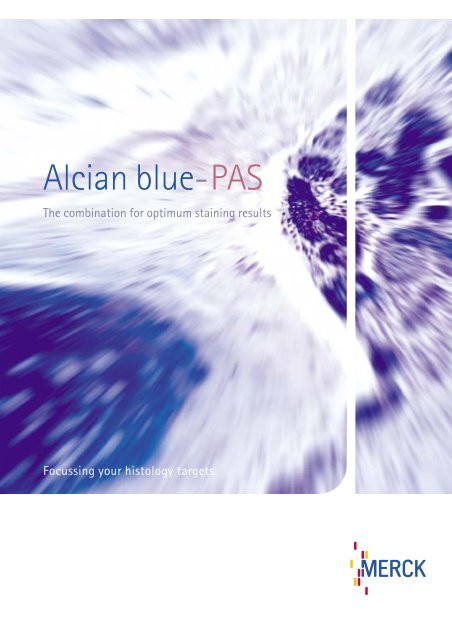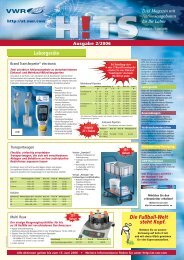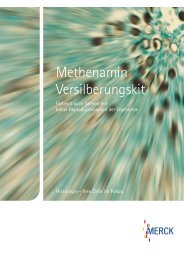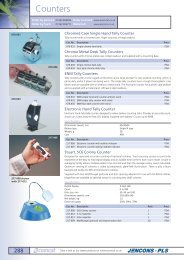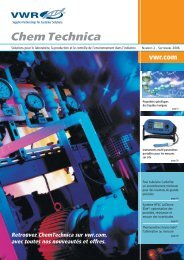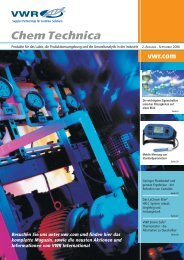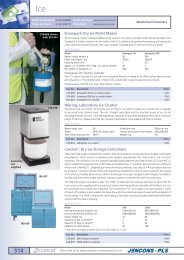You also want an ePaper? Increase the reach of your titles
YUMPU automatically turns print PDFs into web optimized ePapers that Google loves.
<strong>Alcian</strong> <strong>blue</strong>-<strong>PAS</strong><br />
The combination for optimum staining results<br />
Focussing your histology targets.
<strong>Alcian</strong> <strong>blue</strong>-<strong>PAS</strong><br />
Rapid staining<br />
in histology<br />
The <strong>Alcian</strong> <strong>blue</strong>-<strong>PAS</strong> kit combines the brilliance and<br />
reproducibility with the advantage of a rapid stain.<br />
In histology, a wide variety of special stainings is used in addition to H&E staining for<br />
the identification of certain structures or cell constituents. The <strong>PAS</strong> reaction is an<br />
important and widely used staining method for histological preparations. In the <strong>PAS</strong><br />
reaction (periodic acid-Schiff) unsubstituted 1,2 glycols are oxidized to aldehydes<br />
by using periodic acid as an oxidizing agent. These aldehydes react with Schiff’s reagent<br />
to form a bright red to magenta coloured complex. Structures in which the hydroxyl<br />
groups of 1,2 glycols are substituted by amino or alkylamino groups also show<br />
a positive reaction. Polysaccharides, neutral mucopolysaccharides, muco- and glycoproteins,<br />
glycolipids, unsaturated fats and phospholipids can be identified with <strong>PAS</strong>.<br />
Moreover, hyaline, colloid of the thyroid and of the pituitary follicles, ß-granules of<br />
the pituitary and of basal membranes, reticular fibres, renin granules, fungi in dermatomycoses,<br />
epithelial sulfomucins and sialomucins can also be detected.<br />
Also of importance in histology is the identification of acid mucosubstances<br />
(glycosaminoglycans) with <strong>Alcian</strong> <strong>blue</strong>. These mucosubstances can be detected with<br />
<strong>Alcian</strong> <strong>blue</strong> solution having a pH of 2.5.<br />
<strong>Alcian</strong> <strong>blue</strong> solution and <strong>PAS</strong> staining kit are ready-to-use staining solutions which<br />
have been optimally harmonized for the <strong>Alcian</strong> <strong>blue</strong>-<strong>PAS</strong> method. The solutions are<br />
distinguished by excellent quality, reproducible staining results, high yield and long<br />
shelf-life. The combined <strong>Alcian</strong> <strong>blue</strong>-<strong>PAS</strong> staining is a standardized method which can<br />
be carried out with great reliability.<br />
Depending on the objective, <strong>Alcian</strong> <strong>blue</strong> solution as well as <strong>PAS</strong> staining kit can be<br />
used separately.
Pic.1<br />
Pic.2<br />
Pic.3<br />
Pic.1: Cartilage,<br />
<strong>Alcian</strong> <strong>blue</strong>-staining<br />
Pic. 2: Cartilage,<br />
<strong>PAS</strong> -staining<br />
Pic. 3: Cartilage,<br />
<strong>Alcian</strong> <strong>blue</strong>-<strong>PAS</strong> staining<br />
+<br />
=<br />
The visible advantages of<br />
<strong>Alcian</strong> <strong>blue</strong>-<strong>PAS</strong> staining:<br />
• Excellent reproducibility<br />
• High quality<br />
• Optimal tuned reagents<br />
• Ready-to-use reagents<br />
• Easy handling<br />
• Selected raw materials<br />
• Environmentally friendly packaging<br />
• Developed, manufactured and controlled<br />
acc. to DIN EN ISO 13485
Intestine, <strong>PAS</strong><br />
Intestine, <strong>Alcian</strong> <strong>blue</strong>-nuclear fast red<br />
<strong>PAS</strong> staining<br />
<strong>Alcian</strong> <strong>blue</strong>nuclear<br />
fast red<br />
staining<br />
Procedure<br />
1. Deparaffinate and rehydrate<br />
sections in the usual manner<br />
2. Rinse in distilled water<br />
3. Periodic acid 5min<br />
4. Tap water, running 3min<br />
5. Rinse in distilled water<br />
6. Schiff’s reagent 15 min<br />
7. Tap water, running 3min<br />
8. Rinse in distilled water<br />
9. Hermatoxylin solution acc. to Gill III 2min<br />
10. Tap water, running 3min<br />
11. Ascending alcohol series,<br />
2 x Neo-Clear® or xylene<br />
12. Mount with Neo-Mount®<br />
or Entellan® new<br />
Results<br />
Nuclei <strong>blue</strong><br />
Polysaccharides, purple<br />
neutral mucopolysaccharides,<br />
muco- and glycoproteins,<br />
glycolipids, glycogen,<br />
phospholipids,<br />
basal membrane,<br />
collagen<br />
Procedure<br />
1. Deparaffinate and rehydrate<br />
sections in the usual manner<br />
2. Rinse in distilled water<br />
3. <strong>Alcian</strong> <strong>blue</strong> solution 5min<br />
4. Tap water, running 3min<br />
5. Rinse in distilled water<br />
6. Nuclear fast red* 10 min<br />
7. Tap water, running 3min<br />
8. Rinse in distilled water<br />
9. Ascending alcohol series,<br />
2 x Neo-Clear® or xylene<br />
10. Mount with Neo-Mount®<br />
or Entellan® new<br />
* Specification for nuclear fast red solution (with Al2(SO4) 318H2O) available on request.<br />
Results<br />
Nuclei red<br />
Acid mucosubstances <strong>blue</strong>
Intestine, <strong>Alcian</strong> <strong>blue</strong>-<strong>PAS</strong><br />
<strong>Alcian</strong> <strong>blue</strong>-<strong>PAS</strong><br />
staining<br />
Product information<br />
Product Merck Cat.No. Package size<br />
<strong>Alcian</strong> <strong>blue</strong> solution 1.01647.0500 500 ml<br />
<strong>PAS</strong>-staining kit 1.01646.0001 500 ml Schiff’s reagent and<br />
500 ml Periodic acid 0.5%, aqueous<br />
Additional reagents<br />
Procedure<br />
1. Deparaffinate and rehydrate<br />
sections in the usual manner<br />
2. <strong>Alcian</strong> <strong>blue</strong> solution 5min<br />
3. Tap water, running 3min<br />
4. Rinse in distilled water<br />
5. Periodic acid 10 min<br />
6. Tap water, running 3min<br />
7. Rinse in distilled water<br />
8. Schiff’s reagent 15 min<br />
9. Tap water, running 3min<br />
10. Rinse in distilled water<br />
11. Hermatoxylin solution acc. to Gill III 20 sec<br />
12. Tap water, running 3min<br />
13. Ascending alcohol series,<br />
2 x Neo-Clear® or xylene<br />
14. Mount with Neo-Mount®<br />
or Entellan® new<br />
Results<br />
Nuclei <strong>blue</strong><br />
Acid mucosubstances brightly light-<strong>blue</strong><br />
Polysaccharides, purple<br />
neutral mucopolysaccharides<br />
Product Merck Cat.No. Package size<br />
Hematoxylin solution acc. to Gill III 1.05174 500 ml, 1l, 2.5 l<br />
Neo-Clear® 1.09843 5 l, 4 x5 l<br />
Neo-Mount® 1.09016 500 ml<br />
Entellan® new 1.07961 100 ml, 500 ml<br />
Nuclear fast red (C.I. 60760) Certistain® 1.15939 25 g<br />
Ethanol absolute GR for analysis<br />
ACS, ISO, Reag. Ph Eur<br />
1.00983 1 l, 2.5 l, 5 l<br />
Ethanol denatured with about<br />
1% ethyl methyl hetone GR for analysis<br />
1.00974 1 l, 2.5 l
Further information:<br />
Merck KGaA<br />
64271 Darmstadt, Germany<br />
Phone +49 (0) 6151/72-0<br />
Fax +49 (0) 6151/72-33 80<br />
E-mail: microscopy@merck.de<br />
http//: microscopy.merck.de<br />
We provide information and advice to our customers to the best of our knowledge and ability, but without obligation or liability. Existing laws and regulations are to be observed in all cases by our customers.<br />
This also applies in respect to any rights of third parties. Our information and advice do not relieve our customers of their own responsibility for checking the suitability of our products for the envisaged purpose.<br />
W 287116 06/04


